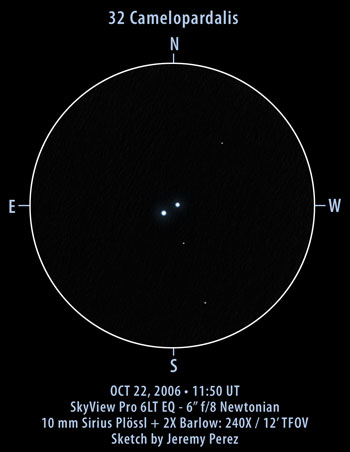
Observation Notes:
This was a little fun to line up, so near the celestial pole. Once I got there, I sighted a wide pair of pale blue stars of nearly equal magnitude. I marked them about 45 arcseconds apart with a PA of 305 degrees. Actual values are 22 arcseconds and 326 degrees, so I was a bit generous on the separation here.
| Subject | 32 Camelopardalis (STF 1694) |
| Classification | Double Star |
| Position (J2000) | [RA: 12:49:13.5 / Dec: +83:24:46]* |
| Position Angle* | 326° (1820) |
| Separation* | 22.0" (1820) 21.5" (1978) |
| Magnitudes* | A = 5.28; B = 5.85 |
| Spectral Types* | A = A2; B = A0 |
| Date/Time | OCT 22, 2006 - 04:50 AM MST (OCT 22, 2006 - 11:50 UT) |
| Observing Loc. | Cinder Hills Overlook, Sunset Crater National Monument, AZ |
| Instrument | Orion SVP 6LT Reflector (150 mm dia./1200 mm F/L) |
| Eyepieces/Mag. | 10 mm + 2X Barlow (240X) |
| Conditions | Clear, calm |
| Seeing | 5/10 |
| Transparency | NELM Mag 6.8+ |
| References | The Washington Visual Double Star Catalog, 1996.0 (Worley+, 1996), Visual Double Stars in Hipparcos (Dommanget+, 2000) via VizieR |
*Based on published data.




